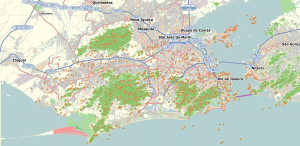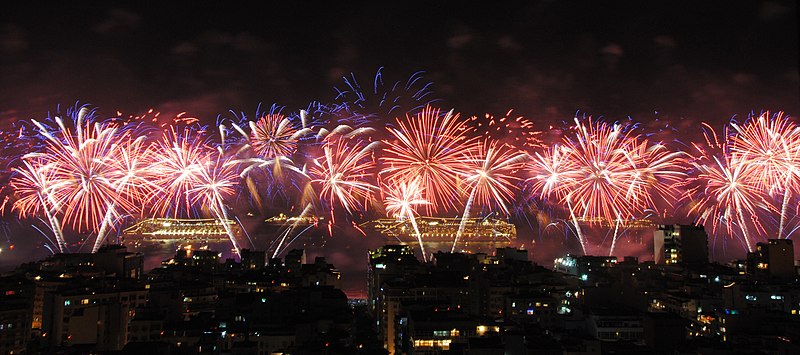|
Copacabana, Rio de Janeiro
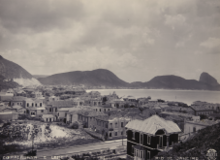 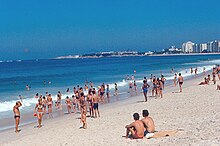   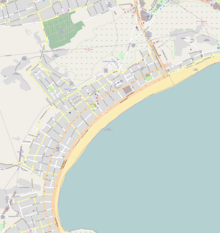 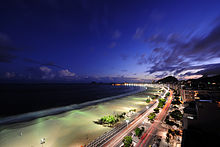    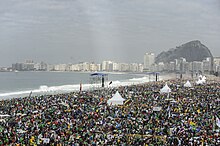 Copacabana (/ˌkoʊpəkəˈbænə/ KOH-pə-kə-BAN-ə, US also /-ˈbɑːnə/ -BAH-nə, Brazilian Portuguese: [ˌkɔpakaˈbɐnɐ]) is a bairro (neighbourhood) located in the South Zone of the city of Rio de Janeiro, Brazil. It is most prominently known for its 4 km (2.5 miles) balneario beach, which is one of the most famous in the world.[1] HistoryThe district was originally called Sacopenapã (translated from the Tupi language, it means "the way of the socós", the socós being a kind of bird) until the mid-18th century. It was renamed after the construction of a chapel holding a replica of the Virgen de Copacabana, the patron saint of Bolivia.[2] CharacteristicsCopacabana begins at Princesa Isabel Avenue and ends at Posto Seis (lifeguard watchtower Six). Beyond Copacabana, there are two small beaches: one, inside Fort Copacabana and the other, right after it: Diabo ("Devil") Beach. Arpoador beach, where surfers go after its perfect waves, comes next, followed by the famous borough of Ipanema. The area served as one of the four "Olympic Zones" during the 2016 Summer Olympics. According to Riotur, the Tourism Secretariat of Rio de Janeiro, there are 63 hotels and 10 hostels in Copacabana.[3] Copacabana BeachCopacabana beach, located at the Atlantic shore, stretches from Posto Dois (lifeguard watchtower Two) to Posto Seis (lifeguard watchtower Six). Leme is at Posto Um (lifeguard watchtower One). There are historic forts at both ends of Copacabana beach; Fort Copacabana, built in 1914, is at the south end by Posto Seis and Fort Duque de Caxias, built in 1779, at the north end. Many hotels, restaurants, bars, nightclubs and residential buildings are located in the area. On Sundays and holidays, one side of Avenida Atlântica is closed to cars, giving residents and tourists more space for activities along the beach. Copacabana Beach plays host to millions of revellers during the annual New Year's Eve celebrations, and for the first three editions of the tournament, has been the official venue of the FIFA Beach Soccer World Cup. Copacabana promenadeThe Copacabana promenade is a pavement landscape in large scale (4 kilometres long). It was rebuilt in 1970 and has used a black and white Portuguese pavement design since its origin in the 1930s: a geometric wave. The Copacabana promenade was designed by Roberto Burle Marx. Living standardCopacabana has the 12th highest Human Development Index in Rio; the 2000 census put the HDI of Copacabana at 0.902.[4] NeighbourhoodAccording to the IBGE, 160,000 people live in Copacabana and 44,000 or 27.5% of them are 60 years old or older.[5][6] Copacabana covers an area of 5.220 km2[7] which gives the borough a population density of 20,400 people per km2. Residential buildings eleven to thirteen stories high built next to each other dominate the borough. Houses and two-story buildings are rare. When Rio was the capital of Brazil, Copacabana was considered one of the best neighborhoods in the country. TransportationMore than 40 different bus routes serve Copacabana,[8] as do three subway Metro stations: Cantagalo, Siqueira Campos and Cardeal Arcoverde. Three major arteries parallel to each other cut across the entire borough: Avenida Atlântica (Atlantic Avenue), which is a 6-lane, 4 km avenue by the beachside, Nossa Senhora de Copacabana Avenue and Barata Ribeiro/Raul Pompéia Street both of which are 4 lanes and 3.5 km in length. Barata Ribeiro Street changes its name to Raul Pompéia Street after the Sá Freire Alvim Tunnel. Twenty-four streets intersect all three major arteries, and seven other streets intersect some of the three. Notable events
New Year's Eve in CopacabanaThe fireworks display in Rio de Janeiro to celebrate New Year's Eve is one of the largest in the world, lasting 15 to 20 minutes. It is estimated that 2 million people go to Copacabana Beach to see the spectacle. The festival also includes a concert that extends throughout the night. The celebration has become one of the biggest tourist attractions of Rio de Janeiro, attracting visitors from all over Brazil as well as from different parts of the world, and the city hotels generally stay fully booked. The celebration is broadcast live on major Brazilian radio and television networks, including TV Globo. HistoryNew Year's Eve has been celebrated on Copacabana beach since the 1950s when cults of African origin such as Candomblé and Umbanda gathered in small groups dressed in white for ritual celebrations. The first fireworks display occurred in 1976, sponsored by a hotel on the waterfront and this has been repeated ever since. In the 1990s the city saw it as a great opportunity to promote the city and organized and expanded the event. An assessment made during the New Year's Eve 1992 highlighted the risks associated with increasing crowd numbers on Copacabana beach after the fireworks display. Since the 1993-94 event concerts have been held on the beach to retain the public. The result was a success with egress spaced out over a period of 2 hours without the previous turmoil, although critics claimed that it denied the spirit of the New Year's tradition of a religious festival with fireworks by the sea. The following year Rod Stewart beat attendance records. Finally, the Tribute to Tom Jobim - with Gal Costa, Gilberto Gil, Caetano Veloso, Chico Buarque, and Paulinho da Viola - consolidated the shows at the Copacabana Réveillon. There was a need to transform the fireworks display in a show of the same quality. The fireworks display was created by entrepreneurs Ricardo Amaral and Marius. From the previous 8–10 minutes the time was extended to 20 minutes and the quality and diversity of the fireworks was improved. A technical problem in fireworks 2000 required the use of ferries from New Year's Eve 2001–02. New Year's Eve has begun to compete with the Carnival, and since 1992 it has been a tourist attraction in its own right.[11] There was no celebration in 2020–21 due to the COVID-19 pandemic, but the fireworks show went on. References
Wikimedia Commons has media related to Copacabana (Rio de Janeiro). |
||||||||||||||||||||

